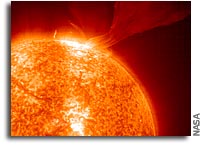New Tools To Tackle a Solar Data Storm

So great is the wealth of data about the Sun now being gathered by space missions such as SOHO, STEREO and the Solar Dynamics Observatory (SDO) that scientists back on Earth can struggle to keep pace. To combat this data overload, scientists from the Visual Computer Centre at Bradford University are developing advanced imaging tools to help scientists visualize what’s happening at the Sun, make sense of the data and predict the extreme solar activities that could affect our lives here on Earth. Dr. Rami Qahwaji will present the tools at the RAS National Astronomy Meeting at Llandudno on Tuesday 19th and Wednesday 20th April.
“These techniques are very important,” said Qahwaji. “We are now able to process images on the ground so that the resolution is double that of the source images. Most satellites are limited by the amount of data that they can store and download. The ability to turn medium resolution images into high resolution in the lab means that satellites can take smaller images but more frequently, which will help with real-time monitoring of the Sun and predicting space weather. It also means that scientists can zoom in on the features that interest them, without downloading huge files. There is lot of potential for this technology. For example, it can help overcome small information loss caused by noise and can be used to generate high-definition 3-D images.”
In addition to enhancing image resolution, the Bradford group has been developing 2- and 3-D visualization tools to help scientists understand the complex processes that drive solar activity. By processing hundreds of solar images, they have created automated maps that summarize solar activity over an entire solar rotation and models of magnetic field lines, generating 3-D visualizations of magnetic loop locations on the Sun’s rotating globe.
“This is the first time that SDO data has been used to create these synoptic maps and we have also created the first automated 3-D model of magnetic loops,” said Qahwaji. “As well as being a useful tool for scientists, we hope that the public will find the 3-D model an interesting way of finding out what’s happening on the Sun.”
The group is now collaborating with Trinity College Dublin on the development of a new flares predictions system called SMART-ASAP. This computerized system analyses recent images to extract physical properties from solar magnetic features that are analyzed further using artificial intelligence techniques to predict whether extreme solar activities will occur.
“Extreme solar activities, such as flares, can affect our life on Earth since we rely more and more on space-based communication and extended power distribution systems, both of which are vulnerable to such activities. The satellite and electrical power industries generate hundreds of billions of dollars in annual revenue and, if we are to protect these assets, we need accurate solar weather forecasting,” said Qahwaji.
Media Contacts:
Dr. Robert Massey
Royal Astronomical Society
+44 (0)794 124 8035 (cell)
rm@ras.org.uk
Anita Heward
Royal Astronomical Society
+44 (0)7756 034 243 (cell)
anitaheward@btinternet.com
NAM 2011 Press Office:
(09:00-17:30 BST, 18-21 April only)
Conwy Room, Venue Cymru, Llandudno, Wales
+44 (0)1492 873 637, +44 (0)1492 873 638
Science Contact:
Dr. Rami Qahwaji
Bradford University
+44(0)1274 236078
r.s.r.qahwaji@bradford.ac.uk
Images & Videos:
http://spaceweather.inf.brad.ac.uk/NAM2011/
# # #
NAM 2011
Bringing together around 500 astronomers and space scientists, the RAS National Astronomy Meeting 2011 (NAM 2011: http://www.ras.org.uk/nam-2011) takes place from 17 to 21 April in Venue Cymru (http://www.venuecymru.co.uk), Llandudno, Wales. The conference is held in conjunction with the U.K. Solar Physics (UKSP: http://www.uksolphys.org) and Magnetosphere Ionosphere and Solar-Terrestrial Physics (MIST: http://www.mist.ac.uk) meetings. NAM 2011 is principally sponsored by the RAS and the Science and Technology Facilities Council (STFC: http://www.stfc.ac.uk).
The Royal Astronomical Society
The Royal Astronomical Society (RAS: http://www.ras.org.uk), founded in 1820, encourages and promotes the study of astronomy, solar-system science, geophysics, and closely related branches of science. The RAS organizes scientific meetings, publishes international research and review journals, recognizes outstanding achievements by the award of medals and prizes, maintains an extensive library, supports education through grants and outreach activities, and represents U.K. astronomy nationally and internationally. Its more than 3,500 members (Fellows), a third based overseas, include scientific researchers in universities, observatories, and laboratories as well as historians of astronomy and others.
The Science and Technology Facilities Council
The Science and Technology Facilities Council (STFC: http://www.stfc.ac.uk) ensures the U.K. retains its leading place on the world stage by delivering world-class science; accessing and hosting international facilities; developing innovative technologies; and increasing the socio-economic impact of its research through effective knowledge exchange. The Council has a broad science portfolio including astronomy, particle astrophysics, and space science. In the area of astronomy it funds the U.K. membership of international bodies such as the European Southern Observatory.
Venue Cymru
Venue Cymru (http://www.venuecymru.co.uk) is a purpose-built conference center and theater with modern facilities for up to 2,000 delegates. Located on the Llandudno promenade with stunning sea and mountain views, Venue Cymru comprises a stunning location, outstanding quality, and exceptional value: the perfect conference package.








